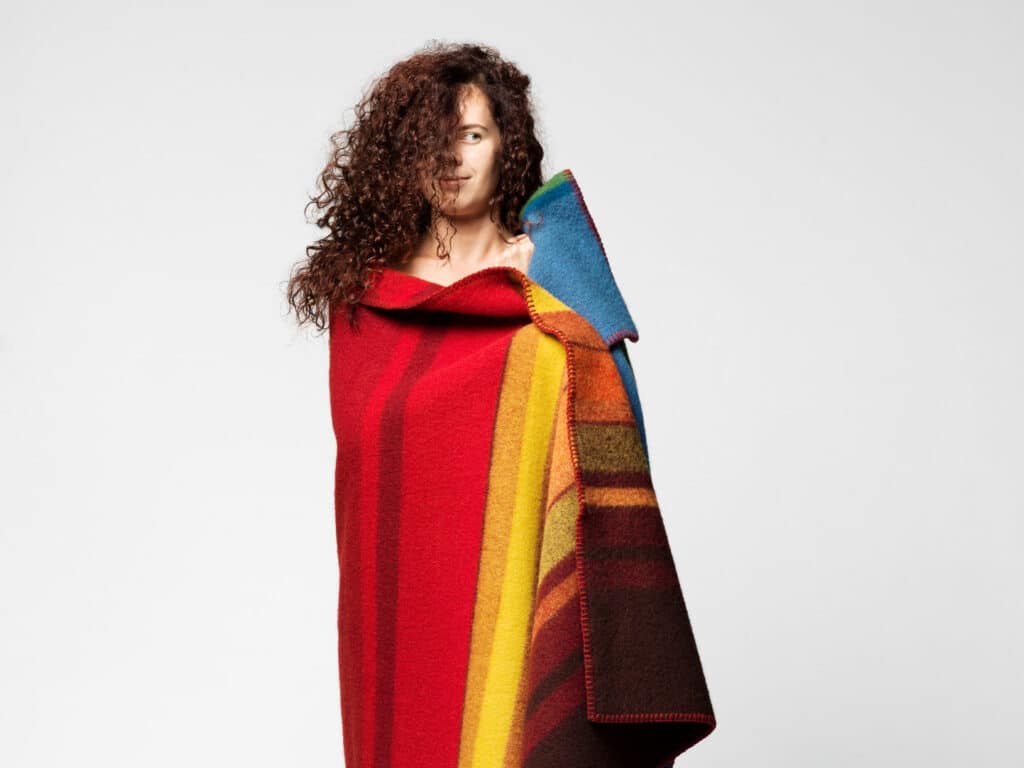For more than 250 years, Falu Rödfärg has had a special relationship with Sweden and the Swedes. The warm, red hue, which borrows its unique pigment from Mother Earth, has signified a sense of security for more than ten generations. The security of a home, of a landscape, of a country.
When we gave the designer Mia Svalänge the assignment of designing a blanket for Falu Rödfärg, she seized the opportunity with great enthusiasm. Her thinking was that it is not possible to separate Falu Rödfärg from Sweden, and that the Swedish landscape is synonymous with this beautiful red hue. Everything is intertwined and connected. It is like a natural weave, from the black earth and dark passageways of the copper mine to the ochre piles of refuse surrounding the mine, to the fields, the meadows, the cornfields, the mountains, the lakes, the rivers, the bright deciduous trees and the shady pine woods, whose tops tickle the blue canopy of the heavens. And there, in the middle of all of this splendour – the barns, the cottages, the bungalows, the outhouses, the fences and palings, whose red shades wax and wane in a constant interplay with the sunlight and seasons.
The description sounds like a painting, and the result is nothing less than a work of art. In its deceptively simple graphic form, it embraces an entire country, its nature and its culture. And you too are welcomed into its warm embrace.
Made of 100% wool, it is soft, warm and cosy, with a genuine lustre that only nature’s materials can produce. When you wrap the blanket around your shoulders, earth and sky meet at the front. And as a symbol of protective and conserving qualities you have the red house wall on your back.

Falu Rödfärg’s blankets and cushions are double-woven on Jacquard looms using two-ply wool warp. The fibre density and choice of wool ensures excellent quality. The weft of the woollen yarn is 14-16 picks per cm. This can be compared with standard plaids which have approximately 5 picks per cm. It is this density – the number of picks per cm – that makes all the difference to the quality of the fabric.
The wool used in our blankets and cushions comes from sheep that graze outdoors all year round in rugged weather conditions. These sheep develop thick guard hairs, the fibres of which have excellent insulation and heat-retention properties.
After weaving, our blankets and cushions are washed and napped before being dried flat. The textile is then steamed to make it as fluffy, soft and warm as possible. Finally, the products are edged by hand and the brand label is sewn on.
The tradition of double weaving in Sweden can be traced back to the Middle Ages, when it was used in several types of mat weaving. Double weaves are characterised by two or more colours, with an almost identical pattern on each side but with variations in colour. These weaves have been considered as Swedish but may possible originate in Italy. The patterns are simplifications of flamboyant Italian weaves and usually form small, symmetrically arranged trees with pairs of birds.
Jacquard looms were the creation of inventor Joseph-Marie Jacquard. They are most commonly mechanically operated, although there are also manual examples. The loom was patented in 1805 and only seven years later there were already 11,000 in use in France. The major difference compared to traditional looms is that each warp thread can be independently controlled. In this way, as many as 1,792 warps can be controlled entirely independently of the other threads’ up and down movement. Electronically controlled Jacquard looms can control almost 10,000 threads independent of one another.
Wool fibres have small scales that move depending on the fibres moisture uptake. This makes the wool felt, which occurs to some extent during moulting, as the fibres tangle with one another and make the product dense. Wool fibres can absorb up to 40% of their own weight in moisture, while also being water repellent. The insulating properties of wool remain intact even when damp. Woollen textiles are self cleaning when exposed to air and sunlight, meaning that they require washing less often if aired at regular intervals. In the event of staining or heavier soiling, textiles can be hand-washed at 30°C or machine-washed on a wool program with a wool/fine washing powder. Textiles should be handled as little as possible during washing in order to avoid felting. Wool is resistant to rot and can be used to insulate houses or, in certain cases, can be recycled as rag paper.